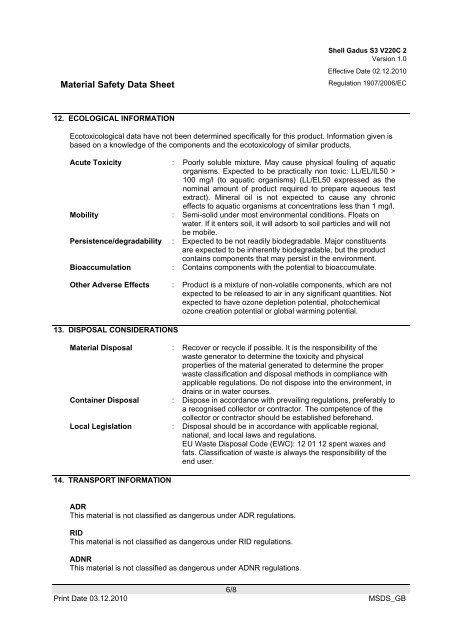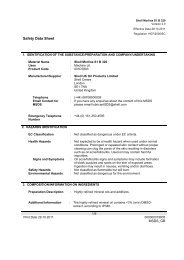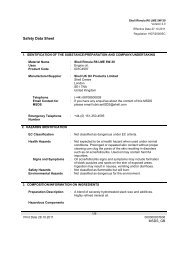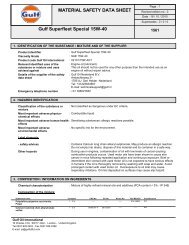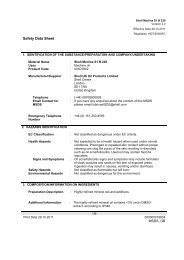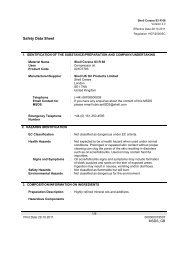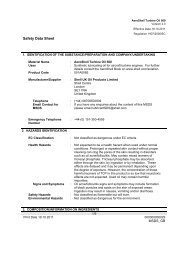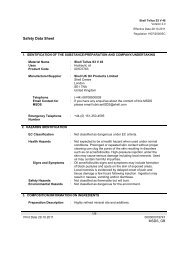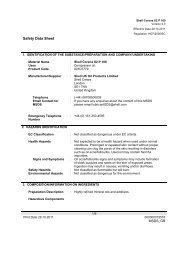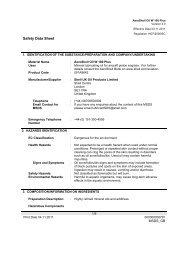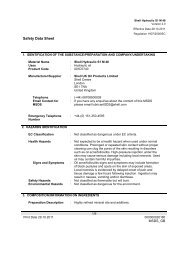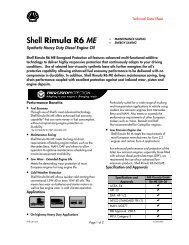Gadus S3 V220C 2.pdf - OilsandStuff
Gadus S3 V220C 2.pdf - OilsandStuff
Gadus S3 V220C 2.pdf - OilsandStuff
You also want an ePaper? Increase the reach of your titles
YUMPU automatically turns print PDFs into web optimized ePapers that Google loves.
Material Safety Data Sheet<br />
Shell <strong>Gadus</strong> <strong>S3</strong> <strong>V220C</strong> 2<br />
Version 1.0<br />
Effective Date 02.12.2010<br />
Regulation 1907/2006/EC<br />
12. ECOLOGICAL INFORMATION<br />
Ecotoxicological data have not been determined specifically for this product. Information given is<br />
based on a knowledge of the components and the ecotoxicology of similar products.<br />
Acute Toxicity<br />
: Poorly soluble mixture. May cause physical fouling of aquatic<br />
organisms. Expected to be practically non toxic: LL/EL/IL50 ><br />
100 mg/l (to aquatic organisms) (LL/EL50 expressed as the<br />
nominal amount of product required to prepare aqueous test<br />
extract). Mineral oil is not expected to cause any chronic<br />
effects to aquatic organisms at concentrations less than 1 mg/l.<br />
Mobility : Semi-solid under most environmental conditions. Floats on<br />
water. If it enters soil, it will adsorb to soil particles and will not<br />
be mobile.<br />
Persistence/degradability : Expected to be not readily biodegradable. Major constituents<br />
are expected to be inherently biodegradable, but the product<br />
contains components that may persist in the environment.<br />
Bioaccumulation : Contains components with the potential to bioaccumulate.<br />
Other Adverse Effects : Product is a mixture of non-volatile components, which are not<br />
expected to be released to air in any significant quantities. Not<br />
expected to have ozone depletion potential, photochemical<br />
ozone creation potential or global warming potential.<br />
13. DISPOSAL CONSIDERATIONS<br />
Material Disposal : Recover or recycle if possible. It is the responsibility of the<br />
waste generator to determine the toxicity and physical<br />
properties of the material generated to determine the proper<br />
waste classification and disposal methods in compliance with<br />
applicable regulations. Do not dispose into the environment, in<br />
drains or in water courses.<br />
Container Disposal : Dispose in accordance with prevailing regulations, preferably to<br />
a recognised collector or contractor. The competence of the<br />
collector or contractor should be established beforehand.<br />
Local Legislation : Disposal should be in accordance with applicable regional,<br />
national, and local laws and regulations.<br />
EU Waste Disposal Code (EWC): 12 01 12 spent waxes and<br />
fats. Classification of waste is always the responsibility of the<br />
end user.<br />
14. TRANSPORT INFORMATION<br />
ADR<br />
This material is not classified as dangerous under ADR regulations.<br />
RID<br />
This material is not classified as dangerous under RID regulations.<br />
ADNR<br />
This material is not classified as dangerous under ADNR regulations.<br />
Print Date 03.12.2010<br />
6/8<br />
MSDS_GB


